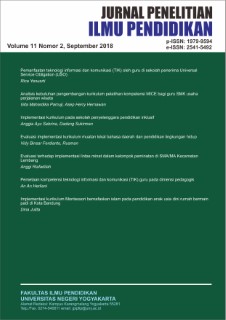Ibu Fatimah dalam Pergumulan Karakter Birokratis dan Profesional
DOI:
https://doi.org/10.21831/jpipfip.v14i1.34078Keywords:
Ibu Fatimah, karakter birokratis, karakter profesionalAbstract
Penelitian ini bertujuan untuk mendeskripsikan perjuangan Ibu Fatimah dalam memerankan karakter profesional dan karakter birokratis secara efektif, di mana karakter birokratis yang kaku dipandang kontra produktif dengan karakter profesional yang dimiliki oleh guru sebagai tenaga pendidik di Sekolah Dasar Negeri AA 1 Malang, namun akhirnya dapat diselaraskan oleh Ibu Fatimah selaku agen perubahan. Data penelitian kualitatif dengan desain studi kasus ini dikumpulkan melalui wawancara dan studi dokumen serta dianalisis menggunakan model analisis kualitatif interaktif. Temuan penelitian menunjukkan bahwa Ibu Fatimah dengan pengalaman dan karakter birokratis dan professional yang dimilikinya berhasil mengubah budaya dan kinerja guru yang rendah, tidak inovatif, tidak memiliki harapan yang tinggi terhadap keberhasilan peserta didik menjadi guru yang professional, inovatif dan memiliki harapan yang tinggi terhadap kesuksesan peserta didik dan juga mengubah paradigma guru yang menerima hak/gaji dengan menunaikan kewajiban seadanya. Untuk penelitian lebih lanjut disarankan agar peneliti berikutnya dapat menggunakan solusi yang lebih fleksibel dalam mengatasi permasalahan yang terkait dengan pengelolaan karakteristik organisasi birokrasi dan profesional di sekolah.
Ibu Fatimah in the Struggle for Bureaucratic and Professional Character
This study aims at describing the struggle of Ibu Fatimah in playing the roles of both bureaucratic and professional characters effectively in which bureaucratic character is regarded as contra-productive with a professional character that owned by teachers as educators at Elementary School AA 1 Malang. However, all the obstacles could be handled by Ibu Fatimah as the agent of change. The qualitative data of this study collected through interviews and document analysis and analyzed using an interactive analysis model. The findings indicate that Ibu Fatimah with her huge experience and having both bureaucratic and professional characters successfully changed the culture and performance of the teachers which were low performance, not innovative, and did not have high expectation on the success of their students, to be professional and innovative teachers as well as having high expectation on the success of their students. She also could change teachers' paradigm that only demanded rights by doing mediocre obligations. For further research, it is recommended to use a more flexible solution to overcome issues regarding how to manage the characteristics of bureaucratic and professional organizations.
References
Adler, P. S. & Borys, B. (1996). Two types of bureaucracy: Enabling and coercive. Administrative Science Quarterly, 41(1), 61-89.
Anderson, G.L & Jones, F. (2000). Knowledge generation in educational administration from the inside out: the promise and perils of site-based, administrator research. Educational Administration Quarterly, 36(3), 428-464.
Aydın, M. (2010). EÄŸitim yí¶netimi. Ankara: HatipoÄŸlu Basım.
Babbie, E. (1995). The practice of social research. (Seventh ed). Belmont, CA: Wadsworth.
Bayhan, G. (2011). í–ÄŸretmenlerin profesyonelliÄŸinin incelenmesi. (Yayımlanmamış doktora tezi). Marmara íœniversitesi EÄŸitim Bilimleri Enstití¼sí¼, Ä°stanbul.
BursalıoÄŸlu, Z. (2012). Okul yí¶netiminde yeni yapı ve davranış. Ankara: Pegem Yayıncılık.
Cerit, Y. (2012). Okulun bí¼rokratik yapisi ile sinif í¶ÄŸretmenlerinin profesyonel davraniÅŸlari arasindaki iliÅŸki. Kuram ve Uygulamada EÄŸitim Yí¶netimi, 4(8), 497-521.
Craig, T. (1995). Achieving innovation through bureaucracy: lessons from the Japanese brewing
industry. California Management Review, 38(1), 8-36.
Creswell, J.W., & Clark, V. L. P. (2007). Designing and conducting mixed methods research. (Third ed). California: Sage Publication.
Creswell, J.W. (2009). Research design: qualitative, quantitative, and mixed methods approaches. (Third ed). California: Sage Publication.
Danim, S. & Suparno. (2009). Manajemen dan kepemimpinan transformasional kekepalasekolahan. Jakarta: Rineka Cipta.
Day, G. (2002). The state of dracula: bureaucracy and the vampire. In Jenkins A., & John, J (eds) Rereading Victorian Fiction. Palgrave Macmillan, London. https://doi.org/10.1057/9780230371149_6.
Ernawan, E. (1988). Peranan birokrasi terhadap peningkatan efektivitas pengambilan keputusan di perusahaan besar. (Skripsi). Tidak diterbitkan. Jakarta: Fakultas Psikologi Universitas Indonesia.
Farah, A. I. (2013). School management: characteristics of effective principal. Global Journal of Human Social Science: Linguistics & Education, 13(3).
Gí¼ven, D. (2010). Profesyonel bir meslek olarak tí¼rkiye'de í¶ÄŸretmenlik. BoÄŸazií§i íœniversitesi EÄŸitim Dergisi, 27(2), 13-21.
Hall, R. D., & Robert, E. Q. (1983). Organizational theory and public policy. London: Sage Publication.
Hamalik, O. (2004). Proses belajar mengajar. Jakarta: Bumi Aksara.
Helterbran, V. (2016). Chapter 12: Teacher leadership: Overcoming "I am just a teacher" syndrome. Counterpoints, 466, 114-120. Retrieved August 24, 2020, from http://www.jstor.org/stable/45157462.
Hoy, W. K., & Miskel, C. G. (2010). EÄŸitim yí¶netimi. (S. Turan, í‡ev.). Ankara: Nobel YayınDağıtım.
Hoy, W. K., & Sweetland, S. R. (2000). School bureaucracies that work enabling, not coercive. Journal of School Leadership, 10(6), 525-41.
Hoy, W. K., & Sweetland, S. R. (2001). Designing better schools: The meaning and measure of enabling school structures. Educational Administration Quarterly, 37(3), 296-321.
Hurley, J. (2016). Chapter 22: Teacher leadership: a new foundation of education? Counterpoints, 466, 186-196. Retrieved August 24, 2020, from http://www.jstor.org/stable/45157476.
Iskandar. (22/11/2018). Peran edutech dalam pemerataan pendidikan di Indonesia. Liputan6. Diakses pada 2017 dari https://www.liputan6.com/tekno/read/3708709/peran-edutech-dalam-pemerataan-pendidikan-di-indonesia
Jaszczyszyn, E., & Lewkowicz, I. (2019). Are innovations a contribution to the professional development of teachers? In Kowalczuk-Walíªdziak M., Korzeniecka-Bondar A., Danilewicz W., & Lauwers G. (eds.), Rethinking Teacher Education for the 21st Century: Trends, Challenges and New Directions. Toronto: Verlag Barbara Budrich. doi:10.2307/j.ctvpb3xhh.20.
Kepenekí§i (Karaman), Y. (1998). Bí¼rokrasi kavramı ve tí¼rkiye eÄŸitim sisteminde bí¼rokrasi, Ä°stanbul: Kí¼ltí¼r Koleji EÄŸitim Vakfı Yayınları.
Maxwell, J.A. (2005). Qualitative research design: An interactive approach. (Second ed). Thousand Oaks, CA: Sage.
Miles, M. B., & Huberman, A. M. (1994). Qualitative data analysis: An expanded sourcebook. Thousand Oaks, CA: Sage.
Moleong, L.J. (2005). Metode penelitian kualitatif. (Edisi Revisi). Bandung: PT. Remaja Rosdakarya.
Mulcahy, D. E. (2019). The role of the school principal in educational reform. International Journal of Leadership in Education. 28(2), 151-161.
Sugiyono. (2014). Metode penelitian manajemen. Bandung: Alfabeta.
Yí¼cel, C. (1999). Bureaucracy and teachers' sense of power (Unpublished doctoral dissertation). Virginia Polytechnic Instituteand State University, USA.
Weber, M. (1947). The theory of social and economic organization. Massachusetts: The Free Press.
Downloads
Published
How to Cite
Issue
Section
Citation Check
License









